1.10 Performing a Group to Group Data Migration
IMPORTANT:This migration option can be performed only if the source volume from which you are migrating has group home folders being managed by Micro Focus Storage Manager for eDirectory group-based collaborative storage policies.
-
Make sure you have completed the prerequisites and have created a migration proxy account. For more information on the prerequisites, see Section 1.3, Prerequisites. For more information on creating a migration proxy account, see Section 1.4, Creating the Migration Proxy Account.
-
In the Admin Client, click the Cross-Empire Data Migration tab.
-
Click eDirectory to Active Directory.
-
Select Migration Wizards > Data and Security.
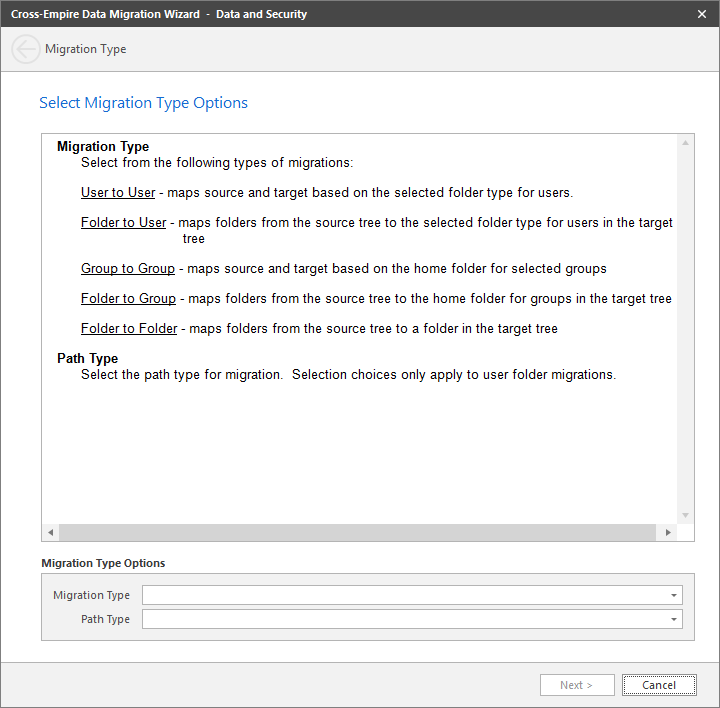
-
From the Migration Type drop-down menu, select Group to Group.
-
Click Next.
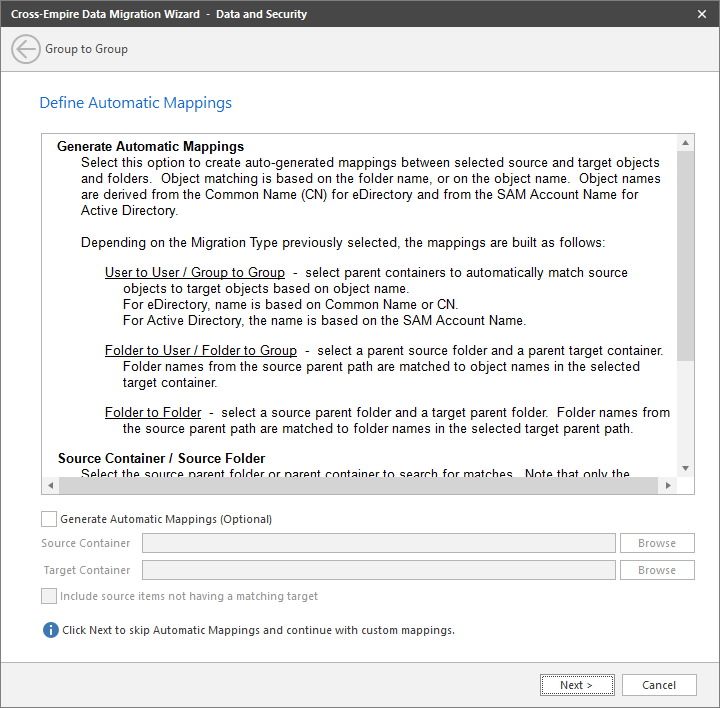
-
Do one of the following:
-
Fill in the following fields:
Generate Automatic Mappings: If you are migrating a large number of groups, select this check box to activate the other fields.
Source Container: Browse to select the source container.
Target Container: Browse to select the target container.
Include source items not having a matching target: Indicate if you want to identify source data not having a matching target.
-
If you are migrating only a few groups, use the Add button in the next wizard page to add the groups individually.
-
-
Click Next.
The Data Migration Wizard attempts to match the Common Names (CN) of objects from the eDirectory source with the SAM (Security Accounts Manager) Account Names in the Active Directory target. If there is a match, the listed object in the Source Object field is selected and a corresponding match is listed in the Target Object column.
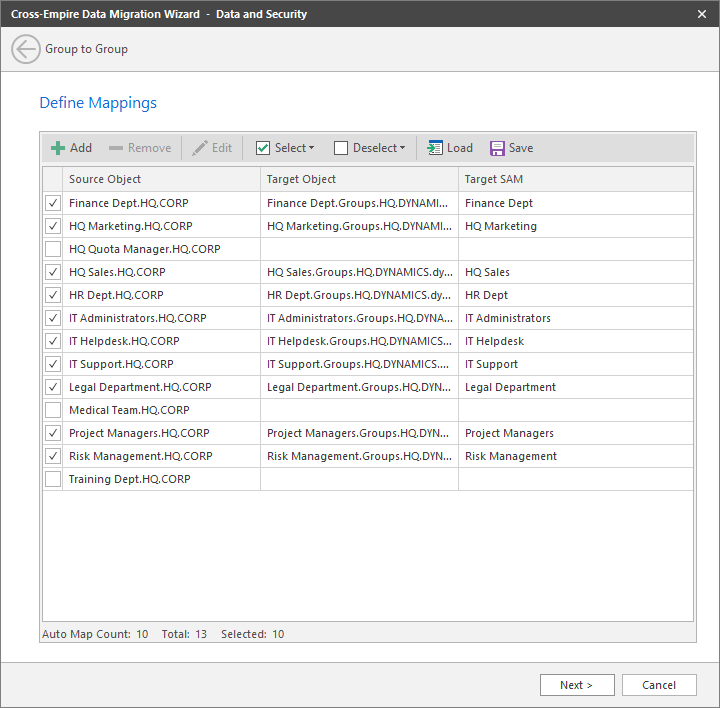
-
Specify a target object for each source object that is not automatically matched by double-clicking the name to bring up the Modify Data Map Entry dialog box.
-
Click Browse, specify the target object, then click OK.
The target object is displayed in the Target Object column.
-
Click the check box corresponding to the listing with the new target.
-
Repeat Step 9 and Step 10 to specify all target objects that are not listed.
To change the specified target object, use the Edit button.
To add an object to the Source Object column, use the Add button.
-
When all of the objects you want to migrate are selected and have an associated target object, click Next.
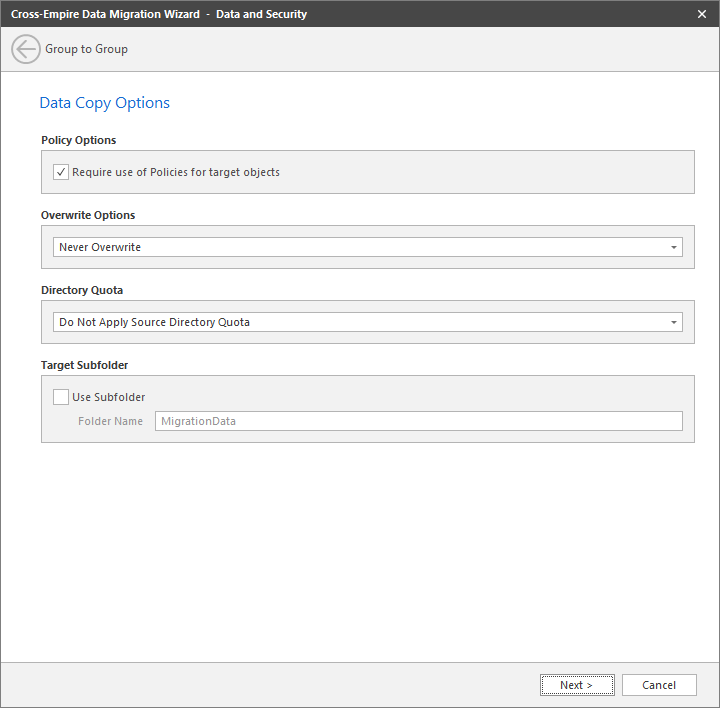
-
Fill in the following fields:
Require use of Policies for target objects: If you are migrating data for objects to an Active Directory container that has an associated File Dynamics policy, leave this check box selected.
If this check box is selected and there is no associated File Dynamics policy, the object’s data is not eligible for migration.
Additionally, if you are migrating a group folder and the target group is not currently managed by an associated policy, but the object does have a policy that would apply to it, File Dynamics will automatically apply that policy to the target object.
If you are migrating group folders to Active Directory objects that do not have policy associations, deselect this check box.
Overwrite Options: Indicate what you want to take place when duplicate filenames are encountered in the source and target.
Directory Quota: Specify how quota settings from the source Novell or Micro Focus file system should be applied after the migration.
Target Subfolder: If you want migrated data to be placed in a subfolder, select the Use subfolder check box and specify the subfolder name in the field.
-
Click Next.
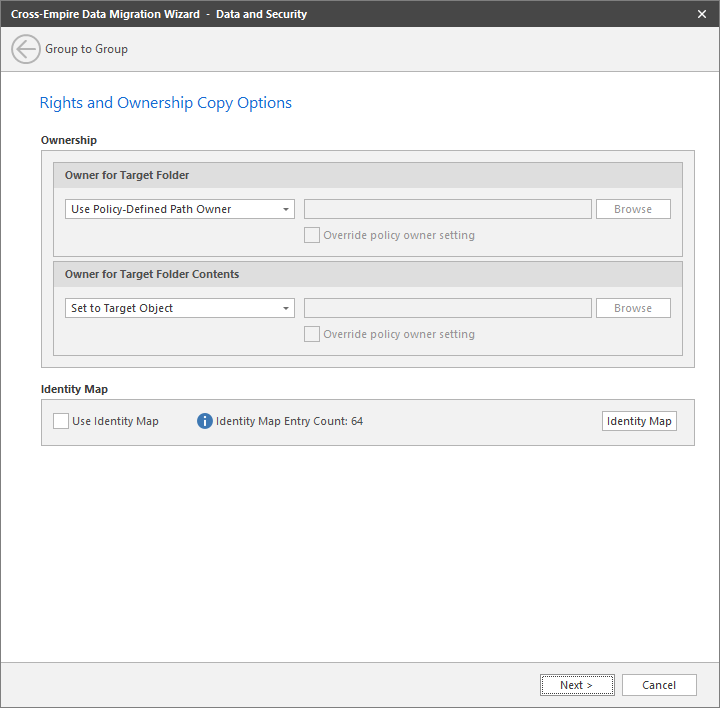
-
Fill in the following fields:
Owner for Target Folder: Use these settings to specify how ownership of the migrated folder is determined.
If you selected the Require use of Policies for target objects check box in the previous wizard page, only the Use Policy-Defined Path Owner and Set Explicit Owner options are available on the drop-down menu.
-
Use Operating System Defaults: This default setting allows the target Microsoft Windows Server to adjust the file ownership according to the settings on the target server.
-
Set to Target Object: Specifies the target object as the owner of the migrated files. If the policy specifies a different owner, the policy’s owner is applied.
-
Use Policy-Defined Path Owner: Ownership of the files is determined according to the settings in the File Dynamics policy associated with the container where the object is managed.
-
Set Explicit Owner: Allows you to browse and select an object as the explicit owner of the migrated folder, unless the policy specifies another object as the owner. To override the policy’s configuration, select the Override policy owner setting check box.
Owner for Target Folder Contents: Use these settings to specify how ownership of the migrated folder contents is determined.
If you selected the Require use of Policies for target objects check box in the previous wizard page, only the Set to Target Object and Set Explicit Owner options are available on the drop-down menu.
-
Use Operating System Defaults: This default setting allows the target Microsoft Windows Server to adjust the file ownership according to the settings on the target server.
-
Set to Target Object: Specifies the target object as the owner of the migrated files. If the policy specifies a different owner, the policy’s owner is applied.
-
Set Explicit Owner: Allows you to browse and select an object as the explicit owner of all of the migrated files, unless the policy specifies another object as the owner. To override the policy’s configuration, select the Override policy owner setting check box.
Use the Identity Map: Selecting this check box indicates that you want File Dynamics to utilize the identity map you created earlier and use the corresponding IDs to copy security rights and file ownership from the Novell or Micro Focus network file system to the Windows network file system.
-
Transfer Rights and Ownership: Selecting this option indicates that you want to transfer the file and folder security rights along with the ownership settings.
Be aware that when you transfer the ownership of a file or folder in a Windows network, you are granting the owner Full Rights, which you might not want to provide.
-
Transfer Rights Only: Selecting this option indicates that you want to transfer only the file and folder security rights.
-
Overwrite Trustees: Selecting this option indicates that you want any existing trustee assignments for a target file or folder to be overridden by the established eDirectory trustee assignments for those files and folders.
-
Merge Trustees: Selecting this option indicates that you want the established eDirectory trustee assignments merged with those of the target files or folders in the Windows network file system.
Identity Map: Clicking this button opens your identity map where you can make any desired changes.
-
-
Click Next.
-
(Conditional) If you want to use a filter to include or exclude specific files, select the Use Copy Filter check box and click the Add button.
-
Fill in the following fields:
Description: Specify a description of the filter.
Action: From the drop-down menu, select either Migrate or Ignore, based on whether the filter specifies to migrate files or folders or to ignore them.
Files, Folders: Specify if the filter applies to files or folders.
Masks: List the file types to migrate or ignore.
-
Specify any additional filter criteria in the menus and fields that remain.
For a detailed explanation of this region of the dialog box, see Setting Vault Rules in the Micro Focus File Dynamics 6.5 Administration Guide.
-
Click OK.
-
-
Click Validate.
Validate shows the result of certain checks that can be run prior to the migration. The Result column shows the status of the validation checks. If errors are displayed, you can choose to correct those errors prior to running the migration.
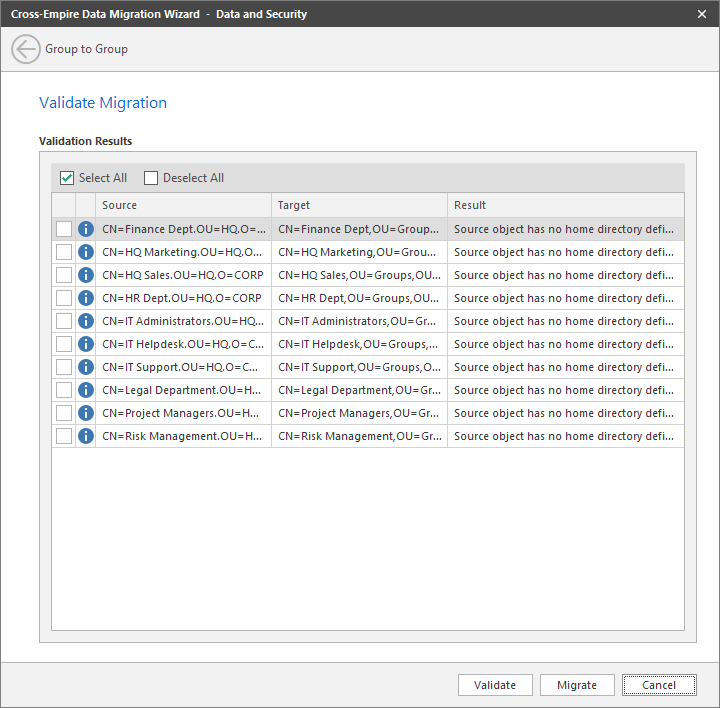
-
(Conditional) Take any necessary action in the Windows network file system target and then validate again.
-
Click Migrate.
A page appears with details of the data migration events that are queued for processing. To view the status of migration events, click Events. For more information on Events, see Pending Events in the Micro Focus File Dynamics 6.5 Administration Guide.
-
Click Finish to close the Data Migration Wizard.